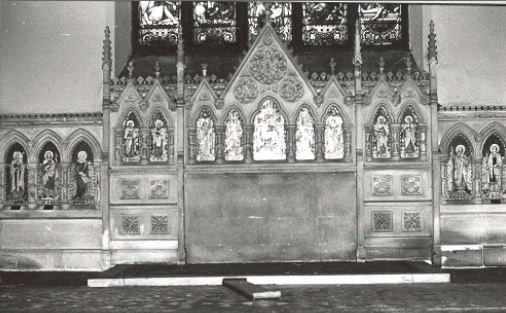St Peter's Church of Ireland Church, Aungier Street
The first reference found to St Peter's dates from the 13th Century. Then in 1371 Pope Gregory said
'...all who should contribute to the restoration of the Parish Church of St. Peter's on the Hill, without
the walls of Dublin….'
A new Church was built in 1685 to replace the ruin of St Peter Del Hille Church, which lay on the
north of the current site within the triangle formed by Great Longford Street, Upper Stephen Street
and Aungier Street.
'In 1625 Sir Francis Aungier obtained a grant to the Whitefriars' estates. A later Francis Aungier
(created Earl of Longford) started developing the area and while building Aungier Street in 1677 also
contributed to the building of the church, which was completed in 1685. The church took the place
of the two older churches, both falling into ruin.' (Dublin 1666–1866, by Maurice Craig).
In the vestry minutes (1686-1736) there is mention of lease calling it Peter Delamont in 1721 and that
in 1729, David La Touche '... enclosed the ground at his own expense'.
'The church was enlarged in 1772 and rebuilt in 1867 in the Gothic style and the original nave walls were
retained' (The Dublin City Churches of the Church of Ireland, by H A Wheeler & M J Craig, 1948).
More seating and the north transept were added in 1773 and it was then renovated between 1864-7 by the
architect Edward Henry Carson (www.dia.ie). James Godkin in his 'Ireland and her Churches', 1867, refers to
it as 'an ugly old building standing in a graveyard which is now being renovated'.
In 1860 the population of the area was approximately 58,000 of which 14,000 were Church of Ireland but
the death knell was sounded following the dismantling of civil parishes. By 1950 there was a major
population decline and it closed for worship on Sunday 28th September 1975 following a service given by
the Rev Canon Richard Dowse. The property was then sold to the Young Men's Christian Association in
1980.
The RCB Library hold the following registers:-
Baptisms 1669-1974
Marriages 1670-1975
Burials 1670-1883
Irishgenealogy.ie have over 70,000 entries online but they are not digitised.
Baptisms 1669 -1900
Marriages 1669-1900
Burials 1667-1910
The RCB Library have architectural drawings of the church, including one of the reredos. It is believed that
the reredos was stored at the derelict St Luke’s Church in the Coombe which was set on fire in 1986.
http://archdrawing.ireland.anglican.org/items/show/2687
A window from the church was installed in the YMCA building and the organ was dismantled in 1977
and moved to St Michael’s (RC) in Blackrock, Co Cork.
'The full grave-slab record has been archived and remains on the premises of Archaeological Development
Services Ltd, where it can be consulted by request.'
© Karen Poff 2015
Further Information
Sources
The first reference found to St Peter's dates from the 13th Century. Then in 1371 Pope Gregory said
'...all who should contribute to the restoration of the Parish Church of St. Peter's on the Hill, without
the walls of Dublin….'
A new Church was built in 1685 to replace the ruin of St Peter Del Hille Church, which lay on the
north of the current site within the triangle formed by Great Longford Street, Upper Stephen Street
and Aungier Street.
'In 1625 Sir Francis Aungier obtained a grant to the Whitefriars' estates. A later Francis Aungier
(created Earl of Longford) started developing the area and while building Aungier Street in 1677 also
contributed to the building of the church, which was completed in 1685. The church took the place
of the two older churches, both falling into ruin.' (Dublin 1666–1866, by Maurice Craig).
In the vestry minutes (1686-1736) there is mention of lease calling it Peter Delamont in 1721 and that
in 1729, David La Touche '... enclosed the ground at his own expense'.
'The church was enlarged in 1772 and rebuilt in 1867 in the Gothic style and the original nave walls were
retained' (The Dublin City Churches of the Church of Ireland, by H A Wheeler & M J Craig, 1948).
More seating and the north transept were added in 1773 and it was then renovated between 1864-7 by the
architect Edward Henry Carson (www.dia.ie). James Godkin in his 'Ireland and her Churches', 1867, refers to
it as 'an ugly old building standing in a graveyard which is now being renovated'.
In 1860 the population of the area was approximately 58,000 of which 14,000 were Church of Ireland but
the death knell was sounded following the dismantling of civil parishes. By 1950 there was a major
population decline and it closed for worship on Sunday 28th September 1975 following a service given by
the Rev Canon Richard Dowse. The property was then sold to the Young Men's Christian Association in
1980.
The RCB Library hold the following registers:-
Baptisms 1669-1974
Marriages 1670-1975
Burials 1670-1883
Irishgenealogy.ie have over 70,000 entries online but they are not digitised.
Baptisms 1669 -1900
Marriages 1669-1900
Burials 1667-1910
The RCB Library have architectural drawings of the church, including one of the reredos. It is believed that
the reredos was stored at the derelict St Luke’s Church in the Coombe which was set on fire in 1986.
http://archdrawing.ireland.anglican.org/items/show/2687
A window from the church was installed in the YMCA building and the organ was dismantled in 1977
and moved to St Michael’s (RC) in Blackrock, Co Cork.
'The full grave-slab record has been archived and remains on the premises of Archaeological Development
Services Ltd, where it can be consulted by request.'
© Karen Poff 2015
Further Information
Sources

